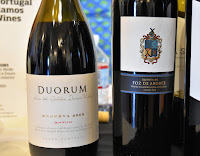Portugal is known for their Port wine, but other wines had been under the radar in international market for some time.
This is changing recently and I experienced the reason of the change at this tasting.
Mouchao from Alentejo.
Mouchao 2011 was aged for 3 years in barrel and 2 years in bottle.
Stewed red fruit, meatiness, and eucalyptus.
Jose Maria da Fonseca's Alambre 2010.
Fortified wine of Moscatel de Setubal.
Sweetness and citrus peel-like acidity. Oxidative qualities of coffee and honey.
Joao Portugal Ramos Wines
Duorum Reserva Old Vines 2009
Big wine, but not harsh. Eucalyptus and tobacco.
Port wines from Sogevinus
Kopke Colheita 1981 had Riesling-like petrol aroma.
Kopke Colheita 1978 was sweet and bitter like coffee jelly.
Kopke Colheita 1967. There was still freshness like ice water.
Kopke Colheita 30 YO White had deep sweetness like Yo-kan (Japanese sweet).
Kopke Colheita 2003 White
All of them had good acidity to balance with the decent sweetness.
Quinta do Passadouro
Passadouro Touriga Nacional 2014
Complex aromas of dried fruit, herb, walnut and spice.
Wine & Soul
Very good wines. This winery can be my favorite.
Guru 2015. White blend wine. Nuts and stone fruit.
Manoella 2014. Fresh fruit and herb. Elegant wine.
Pintas 2014. Red blend of 85 years old vines. Perfumey and elegant tannins.
Pintas Character 2014. Red blend of 60 years old vines. Very expressive.
Quinta da Manoella Vinhas Velhas 2014. Red blend of 120 years old vines. Lots of herbs.
Ramon Pintos
Porto LBV Ramos Pintos 2011
Decent Port wine. Fresh flower and candied fruit.
Estreia Sparkling Loureiro 2016
Sparkling wine made from Loureiro with tank method.
It was fresh, fruity and easy to drink like Prosecco.
Port wines were good of course, and other wines were impressive, too.
The climate of Portugal experiences strong influence from Atlantic ocean but it can be hot and dry inland, so I was expecting that wines would be big, heavy and jammy.
In fact, many of them had strong structure but also had elegance at the same time.
Expressive fruits and herbs with strong backbone. Very good tasting.
























